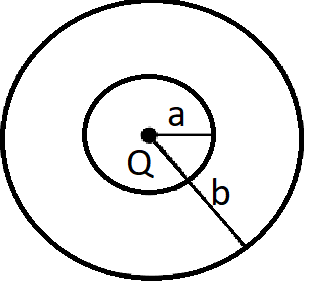Question
Question: The region between two concentric spheres of radii ‘a’ and ‘b’, respectively, has a volume charge de...
The region between two concentric spheres of radii ‘a’ and ‘b’, respectively, has a volume charge density of ρ=rA, where A is constant and r is the distance from the centre. At the centre of the sphere is a point charge Q. The value of A such that the electric field in the region between the spheres will be constant, is:

A. 2πa2Q
B. 2π(b2−a2)Q
C. 2π(a2−b2)Q
D. πa2Q
Solution
This question is an application of the concept of Flux that was given by Gauss. We can easily find the formula using Gauss's Theorem. Take a small element dr and then integrate. While integrating, set a and b as lower limit and upper limit respectively.
Complete answer:
Let us consider a sphere between two concentric spheres lying in the area of radius r and thickness dr. Charging within alone leads to electric field / flux according to Gauss' theorem.

So,
We have
⇒a2kQ=b2k[Q+a∫b4πr2drAr]
Where, k is coulomb’s constant, and a, r, and b are the radii of the three concentric circles respectively.
Now,
On integrating, ‘rdr’
In accordance with the power rule of integration, i.e.,
∫xadx=a+1xa+1
So,
We have
⇒Qa2b2=Q+4πA[2r2]ab
=Q+4πA2(b2−a2)
⇒a2Q(b2−a2)=2πA(b2−a2)
So, now
We have
A=2πa2Q
So, the value of A such that the electric field in the region between the spheres will be constant, is 2πa2Q
So, the correct answer is “Option A”.
Note:
The law of Gauss, also known as the flux theorem of Gauss, is a law of physics relating to the propagation of electric charges to the resulting electric field. A closed one enclosing a volume such as a spherical surface might be the surface under consideration.
